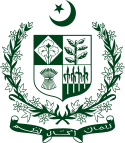
Back سياسة باكستان Arabic Pakistanın dövlət quruluşu Azerbaijani Държавно устройство на Пакистан Bulgarian পাকিস্তানের রাজনীতি Bengali/Bangla Πολιτικά του Πακιστάν Greek Política de Pakistán Spanish Pakistango politika Basque سیاست در پاکستان Persian Politique au Pakistan French पाकिस्तान की राजनीति Hindi
This article needs to be updated. (June 2018) |
 |
|---|
|
|
The Politics of Pakistan (سیاسیاتِ پاکستان ; ISO: Siyāsiyāt-e-Pākistāna) takes place within the framework established by the constitution. The country is a federal parliamentary republic in which provincial governments enjoy a high degree of autonomy and residuary powers. Executive power is vested with the national cabinet which is headed by Prime Minister of Pakistan (Shehbaz Sharif since 3 March, 2024), who works with the bicameral parliament and the judiciary.[1] Stipulations set by the constitution provide a delicate check and balance of sharing powers between executive, legislative, and judicial branches of the government.[2]
The head of state is the president who is elected by the electoral college for a five-year term. Asif Ali Zardari is currently the president of Pakistan (since 2024). The president was a significant authority until the 18th amendment, passed in 2010, stripped the presidency of most of its powers. Since then, Pakistan has shifted from a Semi-presidential system to a purely parliamentary government. Since the amendment, the president's powers include the right to pardon and the ability to suspend or moderate any sentence passed by any court or authority.[3]
The government consists of three branches: executive, legislative and judicial. The Executive branch consists of the Cabinet and is led by the Prime Minister. It is totally independent of the legislative branch that consists of a bicameral parliament. The Upper House is the Senate whilst the National Assembly is the lower house.[4] The Judicial branch forms with the composition of the Supreme Court as an apex court, alongside the high courts and other inferior courts.[5][6] The judiciary's function is to interpret the Constitution and federal laws and regulations.[7][8]
Pakistan is a multiparty democracy where several political parties compete for seats in the National and Provincial assemblies. However, as an aftermath of the Fall of Dhaka in 1971, a two-party system was developed between the People's Party and Muslim League. There has also been a sharp rise in the popularity of centrist parties such as PML-Q and PTI.[9][10] The Armed Forces has historically played an influential role in the country's politics, although it has declined in recent years.[11] From 1950s to 2000s, several coups were staged that overthrew democratic regimes.[12][13][14][15] After the resignation of President Pervez Musharraf in 2008, a sharp line has been drawn between the "military establishment" and politics and Pakistan is moving closer to becoming a democracy after general elections in 2013.[16][17] Imran Khan ascended to leadership in 2018 with the backing of the military, but was subsequently removed from power in 2022 after losing that support.[18][19] However, he won re-election in 2024.[11] No Prime Minister of Pakistan has ever completed their full length tenure.[20] I
The Economist Intelligence Unit rated Pakistan an "authoritarian regime" in 2023.[21][needs update] According to the V-Dem Democracy indices Pakistan was 2023 the 20th most electoral democratic country in Asia.[22] In 2023, according to Freedom in the World, report by Freedom House, Pakistan is categorised as a "partly free" country and it is categorised as "not free" in terms of internet freedom.[23]
- ^ "Part I: "Introductory"".
- ^ See Part III: The Federation of Pakistan of the Constitution of Pakistan
- ^ "Chapter 3: "The Federal Government" of Part III: "The Federation of Pakistan"".
- ^ Parliament of Pakistan. "Parliament of Pakistan". na.gov.pk/. Parliament of Pakistan press. Retrieved 3 March 2015.
- ^ Supreme Court. "Court system of Pakistan" (PDF). supremecourt.gov.pk/. Supreme Court of Pakistan Press, PDF. Archived from the original (PDF) on 6 February 2017. Retrieved 3 March 2015.
- ^ Supreme Court of Pakistan press. "Judicature Branch". supremecourt.gov.pk/. Supreme Court of Pakistan press. Archived from the original on 24 March 2015. Retrieved 3 March 2015.
- ^ "The Judicature". Archived from the original on 24 November 2018. Retrieved 3 March 2015.
- ^ "Chapter 1: "The President" of Part III: "The Federation of Pakistan"".
- ^ Haqqani, Husain (2005). Pakistan between mosque and military. Washington, D.C.: Carnegie Endowment for International Peace. ISBN 0870032852.
- ^ Aziz, c Mazhar (2009). Military control in Pakistan : the parallel state (Transferred to digital printing. ed.). London: Routledge. ISBN 978-0415544740.
- ^ a b Malik, Adeel; Tudor, Maya (2024). "Pakistan's Coming Crisis". Journal of Democracy. 35 (3): 69–83. ISSN 1086-3214.
- ^ Hasan, Mubashir (2000). The mirage of power. Karachi: Oxford University Press. ISBN 9780195793000.
- ^ Jones, Owen Bennett (2003). Pakistan eye of the storm (2nd ed.). New Haven, Conn.: Yale University Press. ISBN 9780300101478.
- ^ Chadda, Maya (2000). Building democracy in South Asia : India, Nepal, Pakistan. Boulder [etc.]: L. Rienner. ISBN 1555878598.
- ^ Cohen, Stephen Philip (2006). The idea of Pakistan (Rev. ed.). Washington, D.C.: Brookings Institution Press. ISBN 978-0815715030.
- ^ Christophe Jaffrelot; translated by Beaumont Gillian, eds. (2004). A history of Pakistan origins (New ed.). London: Anthem. ISBN 1843311496.
- ^ Lieven, Anatol (2011). Pakistan a hard country (1st ed.). New York: PublicAffairs. ISBN 978-1610390231.
- ^ "The Military Disrupts Pakistan's Democracy Once Again".
- ^ "Pakistan: Five major issues to watch in 2023". Brookings. Retrieved 8 July 2023.
- ^ "No Pakistani prime minister has completed a full term in office". www.aljazeera.com. Retrieved 21 October 2023.
- ^ "Democracy Index 2022: Frontline democracy and the battle for Ukraine" (PDF). Economist Intelligence Unit. 2023. Retrieved 9 February 2023.
- ^ V-Dem Institute (2023). "The V-Dem Dataset". Retrieved 14 October 2023.
- ^ "Pakistan: Freedom in the World 2023 Country Report". Freedom House. Retrieved 21 October 2023.
© MMXXIII Rich X Search. We shall prevail. All rights reserved. Rich X Search


